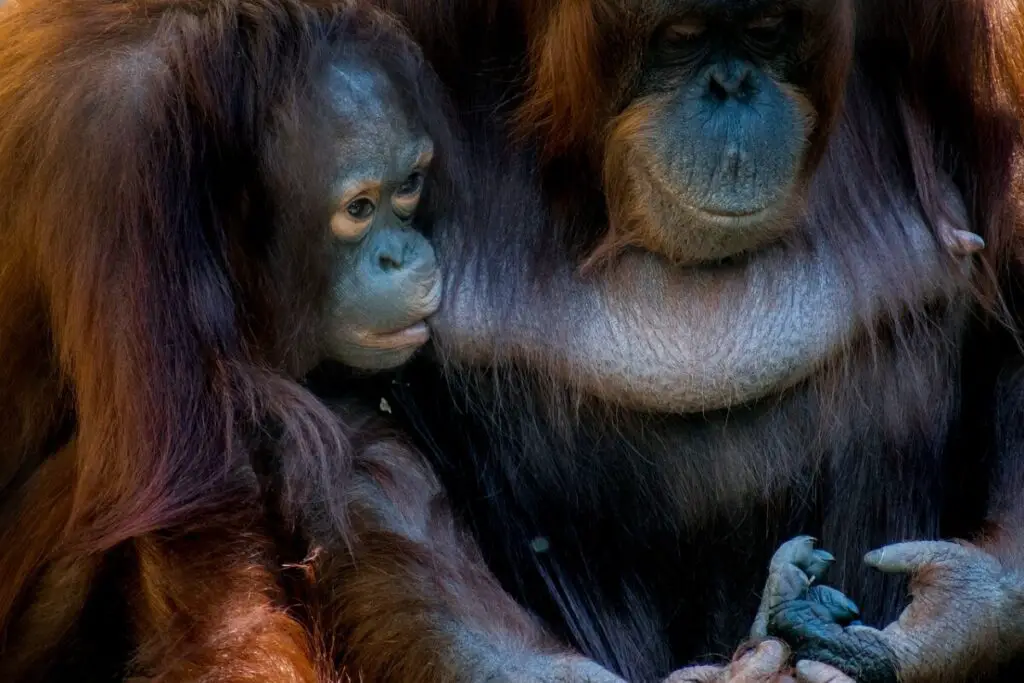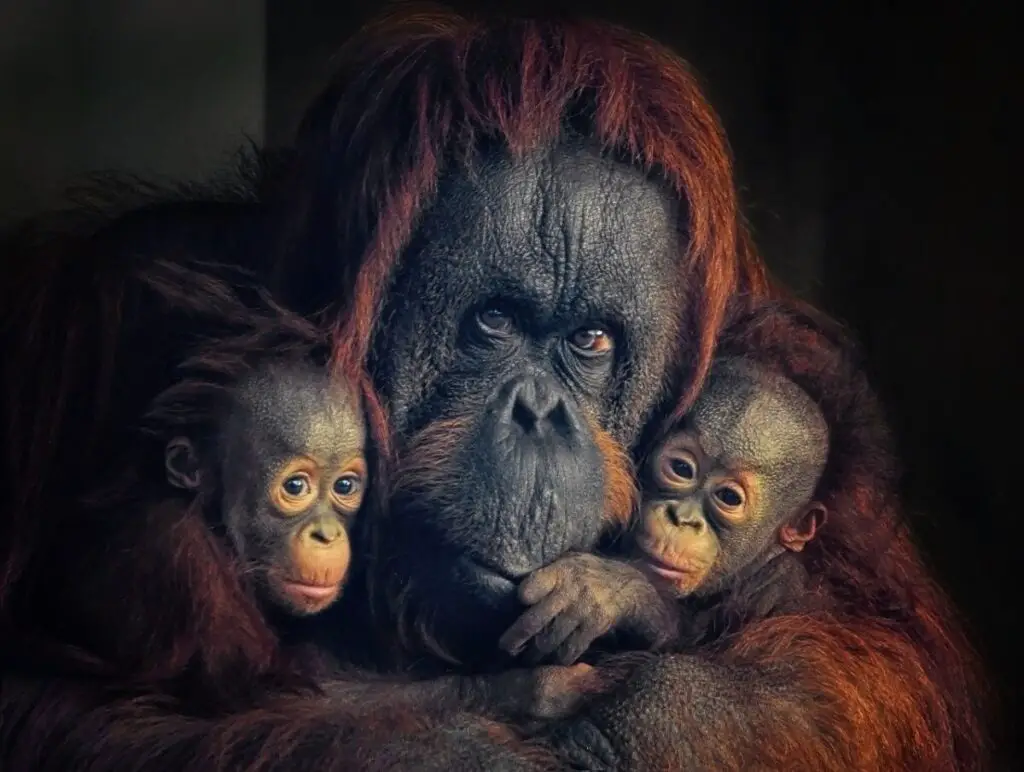The Bornean orangutan (Pongo pygmaeus) is a species of great ape native to the island of Borneo. Endemic to this region, they are considered critically endangered due to habitat destruction and illegal hunting. This article will explore the ecology, conservation status, and current issues surrounding the Bornean orang-utan.
Orangutans are the largest arboreal mammal in the world; their long arms making them particularly adapted for life in trees. They live solitary lives with overlapping home ranges that vary depending on sex and age class.
Adult males have larger ranges than adult females, which allows for greater access to food resources as well as potential mating opportunities. Diet consists mainly of fruit but also includes over 300 plant species such as leaves and bark.
Threats facing orangutans include deforestation caused by logging operations and conversion of land for palm oil plantations. Illegal trade of juvenile animals has resulted in population declines throughout most parts of its range.
Conservation initiatives focus heavily on protection of remaining forested areas through enforcement of laws prohibiting capture or killing of wild individuals as well as replanting efforts to restore degraded habitats.

Overview Of The Bornean Orang-Utan
The Bornean orang-utan is a species of great ape native to the island of Borneo. It is one of three extant species of orang-utans, alongside the Sumatran and Tapanuli orang-utans. The genus Pongo includes all three species within it, with the Bornean being placed in the subgenus Pygathrix. This particular species is found primarily in tropical rainforest habitats on the islands of Kalimantan and Sabah in Indonesia, as well as Sarawak in Malaysia.
Primarily arboreal, individuals display various behaviors that are indicative of their adaptation to life in trees such as brachiation (swinging from branch to branch) and knuckle walking. Orang-utans have long arms which they use for balance while moving through trees and can be up to twice as long as their legs.
They also possess strong hands capable of grasping branches securely while climbing or swinging through foliage; this trait has enabled them to evolve an impressive array of locomotor skills not seen amongst other primates.
An adult male will weigh between 70–150 pounds depending on age and location whilst female adults range from 35–60 pounds on average. These primates feed mostly on fruits but have been known to supplement their diets by consuming leaves, bark, insects, bird eggs, mushrooms and honey when available.
Furthermore, due to habitat destruction caused largely by human activity there are now fewer than 14000 mature individuals remaining in the wild making conservation efforts more critical than ever before for this endangered species.
Evolutionary History Of The Bornean Orang-Utan
The Bornean orang-utan is a species of great ape that has a long and complex evolutionary history. This history can be traced back to the Miocene Epoch, which was around 23 million years ago.
During this time, the ancestors of modern apes diverged from Old World monkeys due to environmental changes in Africa. From there, they migrated to Southeast Asia where they eventually evolved into the three extant genera: Pongo (orangutans), Gorilla (gorillas) and Pan (chimpanzees).
This migration marks an important event in primate evolution as it led to increased adaptation and diversification among these early hominoids. The Bornean orang-utan is one of two species within the genus Pongo; its sister species being the Sumatran orang-utan.
It is thought that both species separated approximately 400,000 years ago when sea levels rose significantly during glacial maxima periods, creating physical barriers between them on either side of what is now known as Sundaland – an area encompassing Java, Malaysia and Singapore.
Genetic studies have revealed further details about the evolution of this species. For example, researchers have identified at least four distinct subspecies within the Bornean orang-utan population based on their mitochondrial DNA sequences.
These findings suggest that not only did different populations evolve independently but also interbred with each other throughout their separation events. Such adaptive radiation has enabled this species to survive despite changing environmental conditions over millions of years.
Habitat And Distribution Of The Bornean Orang-Utan
The Bornean orang-utan is a species of great ape that lives in the tropical lowland rainforests and mountain forests across Kalimantan, Sabah, and East Malaysia. The largest population can be found in the Gunung Palung National Park on the western coast of Borneo.
They are arboreal animals, meaning they spend most their life living high up in trees with occasional periods spent on the ground.
Orang-utans live extensively through several parts of Southeast Asia including Indonesia’s Sumatra Island as well as Sarawak and Sabah provinces in Malaysian Borneo. However, due to deforestation caused by palm oil production and other human activities, their habitats have been greatly reduced over time; this has put increasing pressure on wild populations leading to fragmentation and isolation from one another.
As a result of these factors, it is estimated that there are only about 104,700 individuals left in the wild today according to the International Union for Conservation of Nature (IUCN).
Given its status as an endangered species, immediate action needs to be taken if we hope to preserve future generations of orang-utans. This includes initiatives such as protecting existing habitat corridors connecting fragmented forest areas so that animals can move freely between them without being threatened by humans or predators.
Moreover, research into understanding more about what drives changes in their behavior may help us better protect them from extinction.
Diet And Feeding Habits Of The Bornean Orang-Utan
The Bornean orang-utan is an arboreal species, meaning it mostly lives in trees and uses them for shelter. Consequently, its diet is based on what can be found among the branches of the rainforest canopy. Their main sources of sustenance are fruits, shoots, leaves, bark and insects. They have also been known to occasionally eat bird eggs as well as small mammals such as squirrels and monkeys.
Orang-utans typically forage during the morning hours when food sources are most abundant. During this time they may travel up to four kilometers per day from tree to tree gathering food and eating along the way.
To conserve energy while traveling through the treetops, they often use a form of brachiation (moving by swinging between branches). After mid-day they return to their resting spot where they will spend several hours digesting their meal before beginning again at dusk.
In order to meet their dietary requirements and survive in their habitat, orang-utans must have access to both primary forest resources such as fruit trees and secondary forest areas with more varied options like lianas and ground vegetation. As a result, conservation efforts should focus on preserving not only primary forests but also nearby secondary habitats which provide essential nutrition for these apes.

Social Behaviour Of The Bornean Orang-Utan
Bornean orang-utans are highly social primates, living in groups that can range from two to nine individuals. They display a variety of complex behaviors within these groups including cooperative and altruistic behavior, reciprocity, communication, grooming and play. These activities strengthen the bonds among group members, helping them to form stable relationships over long periods of time.
Orang-utans also show an understanding of how their actions affect others in their group. For example, they have been observed displaying guilt when reprimanded for stealing food by other members of the troop.
This suggests that they understand the impact of their behaviour on their peers and make efforts to avoid antagonizing them in order to maintain peaceful relations. Furthermore, females often share food with males as part of courtship rituals which helps facilitate pair bonding between potential mates.
In addition to forming strong bonds amongst themselves, Bornean orang-utans also interact with members of other troops through vocal exchanges known as ‘long calls’. Long calls may be used as territorial warnings to deter trespassers but are more commonly seen during times when mating is most likely – such as at night – indicating that it could serve a role in mate selection too.
Breeding Habits Of The Bornean Orang-Utan
The Bornean orang-utan is a solitary species, and it breeds in the wild only once every 7 to 8 years. The female gives birth to one offspring at a time typically, though twins are not uncommon. In most cases, a single male will mate with multiple females but males often have exclusive mating relationships with certain females as well.
Gestation for this species lasts between 8 and 9 months, after which point the mother carries her infant until he or she can move independently around 3 to 4 years of age. During the first two weeks postpartum, the mother exclusively cares for her newborn while other members of their social group assist by providing food resources like fruits and insects during this critical period.
After that initial stage, mothers begin weaning their young from breast milk onto solid foods such as seeds and leaves; weaning concludes when infants reach approximately 18 months old.
At around three years of age, juvenile orangutans become independent, although they may still rely on their mothers for protection against predators for several more years afterwards. Male juveniles typically disperse from their natal home range before adulthood whereas females tend to remain within the same area where they were born for much longer periods of time even into adulthood.
Challenges Faced By The Bornean Orang-Utan
The Bornean orang-utan is a species of great ape native to the island of Borneo in Indonesia and Malaysia, yet it faces many challenges. Degradation of its natural habitat due to human activity such as deforestation for logging and palm oil plantations is one of the biggest threats that this species has been facing since the 20th century.
Increasing industrialisation on the island of Borneo has caused conversion of land into agricultural fields, resulting in fragmentation, degradation, and destruction of habitats previously used by these primates.
In addition to habitat loss, hunting further contributes to population decline in this species. Hunting for food, pet trade activities and other commercial purposes are some factors driving illegal hunting practices which greatly reduce wild orang-utan populations.
Moreover, climate change poses an additional threat where unexpected weather patterns can cause disruption to their environment leading to reduced availability of resources necessary for survival.
Since 2000 there have been efforts from conservation organisations like The Orang-utan Project (TOP) aimed at providing long term protection for both wild and rehabilitated orangutans through education campaigns and initiatives such as planting trees on degraded lands.
Furthermore, TOP works with local communities living near protected areas teaching them about sustainable farming techniques instead of destructive slash-and-burn methods commonly used in rural parts of Southeast Asia. Despite these efforts however, more needs to be done if we want future generations to continue enjoying coexistence with our primate relatives on the beautiful island of Borneo.
